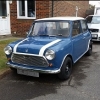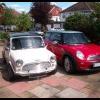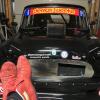Help Please! Wheel Arch Problems.
#1

Posted 11 December 2015 - 12:31 AM
Every time I go round a right hand corner, an unbearable rubbing noise occurs and I've had just about enough! I've raised my suspension, but due to it sitting forward in the arch it still happens often.
Any help, or Advice on how to fix it.
Thanks
#2

Posted 11 December 2015 - 07:04 AM
#3

Posted 11 December 2015 - 07:09 AM
As the factory bodyshell tooling became worn in later years the front panelwork and wings on Mini's varied more and more from one side to the other.......these shims below were added, often several more on one side to try to even up the gaps from wheel to wheel arch each side and prevent tyres rubbing on full lock.
"Fitted to rubber mounted subframes from 1976 on this packing piece goes between the front panel and the subframe mounting points. You might be surprised how many of these were fitted to your car when it came out the factory. When replacing the front panel or mountings you should repack them accordingly. They are open end shaped to slide in over the bolt."
http://www.minispare...sic/2A4292.aspx
"A set of 8 Mini front subframe shims (2A4292) in stainless steel exact reproductions of the original Rover ones fitted.
These are a must when you are renovating the mini shell to get the front panel and subframe to align correctly, they fit between the subframe and pear drop mount.
Made from stainless steel."
http://www.minisport...eel-2a4292.html
Edited by mab01uk, 11 December 2015 - 07:11 AM.
#4

Posted 11 December 2015 - 07:22 AM
Edited by dave1010, 11 December 2015 - 07:24 AM.
#5

Posted 11 December 2015 - 08:19 AM
there are some measurements in the Haynes manual, in the Aux or bodywork section. (thinks it is the body work section).
#6

Posted 11 December 2015 - 09:04 AM
Out of curiosity is the shim placed between the subframe and the rubber mount, or at the top between the body and the mount?
#7

Posted 11 December 2015 - 09:19 AM
Out of curiosity is the shim placed between the subframe and the rubber mount, or at the top between the body and the mount?
they fit between the subframe and pear drop mount.
#8

Posted 11 December 2015 - 12:34 PM
Ah, cool, it has had a new subframe fitted before I got it. How do you go about setting it up right, are there points to measure from?
Add more shims to the side that is rubbing as a starting point, as this should increase the wheel to arch gap. However there are limits to how much you can pack out....see the Keith Calver Minispares advice below:-
Wheels & tyres - Problems with 12-inch wheels rubbing
"Having applied Hi-Los and some smart 165/60/12 profile tyre shod12 x 5-inch ally rims, discussions get around to a subject that has cropped up a zillion times in the Knowledge, at shows, my e-mail address, etc. - just why does this combination cause the tyre to hit the front arch?
To be more exact - why does the tyre just rub, twang the plastic arch off, or foul the arch to the point of bending it? Even if the genuine, original fitment 'Cooper' alloy 12-inch rims are used with the 165/60/12 tyres? Well, it's all a question of alignment - either subframe to body or suspension to subframe. When trying to source/cure the problem, many folk have discovered that shim plates have been used between the front panel to subframe teardrop mounting and the subframe - and wonder if the car has been in an accident and been 'fudged', so could be causing the problem.
The answer is more than likely not. Those shims are actually a Rover part, fitted at the factory - not to re-align the subframes as some folk believe (be impossible when you consider the magnitude of the tower mounting bolts and rubbers!) - but to push the front panel forwards to give clearance to the tyres… Backing the truck up a bit here, there is basically two reasons why misalignment is causing the tyres to foul the arch, which, incidentally, generally occurs between three and six inches above the top edge of the bumper on the leading edge of the front arch line. The first one to check is the tie-rods - the components that go from the outer end of the bottom arm forwards to the front of the front subframe. I have seen many of these bent - they're supposed to be straight. A bent tie-rod pulls the wheel/tyre forwards, increasing the caster angle and causing it to hit the arch. The general cause of this is the car being jacked up on the tie-rod bracket where it bolts to the subframe. I've seen this all too often at tyre fitting centres. As the car is raised in this fashion, the suspension drops, the tie-rod rests on the outer edge of the jacks 'cup' and the powerful rubber spring combined with the suspension weight causes the tie-rod to bend. They're only made of basic steel. They can be straightened - but they cost little, so fit new ones along with new bushes. Having assessed and sorted any problems with the tie-rods get the suspension geometry checked. The manufacturers tolerances are quite wide, but shouldn't cause the fouling problem.
I have, however, come across a few cars where the geometry is outside the standard tolerances. Again it's the caster angle causing the problem. Somehow those cars ended up with an extra degree of caster on one wheel. Unfortunately I didn't have sufficient time to source the cause, but fixed it by using one of the aftermarket harder tie-rod bushes fitted to the wheel side of the tie-rod where it fits to the front subframe. This pushes the wheel back, getting the caster angle back within the specified limits, and stopping the fouling problem.
Happy the tie-rods and caster angles are sorted, it's time to consider the panel work. Now, the reason why Rover had to start using these spacer-shims between the front panel teardrop mounting and the subframe on the 12-inch wheeled Coopers is because the bodyshells were a bit misaligned, and the subframes were not always totally square fitted into the shell. Consequently these spacer-shims were used to push the front panel forwards, away from the tyres. So this is another avenue of attack - except there is a point of no return here. The arch reaches a point where it is being pushed so far forwards by over-use of the spacer-shims it starts deforming in towards the centerline of the car, thus causing the arch line to bend backwards slightly.
Back to square one with the fouling thing. Some folk have tried fitting wheel spacers to the front wheels. This is not at all recommended for safety reasons and it is very unlikely to solve the problem since moving the wheel/tyre further out increases it's peak turning arc, making the tyre more likely to foul. So if you suffer from this affliction, check your tie-rods and caster angles first, then cogitate the issue of the panel work. If it's neither of these - it could be serious… Useful part numbers: 8G4249 Standard tie-rod assembly complete with all new bushings and washers, nuts and bolts. 21A450 Standard tie-rod only. 21A1091 Heavy-duty adjustable tie-rods, pair. 31G1155 Standard rubber tie-rod bush, 2 needed per side C-STR628 Up-graded tie-rod bushings for fast road use, set of 4 C-STR629 Very hard competition use only tie-rod bushings, set of 4."
Edited by mab01uk, 11 December 2015 - 12:42 PM.
1 user(s) are reading this topic
0 members, 1 guests, 0 anonymous users

















